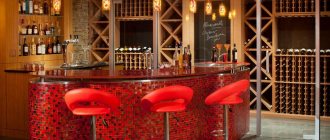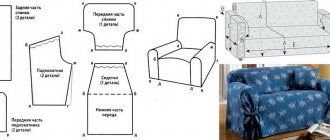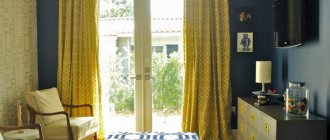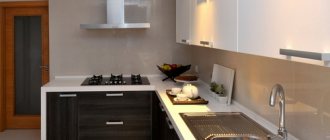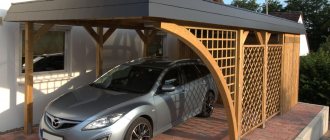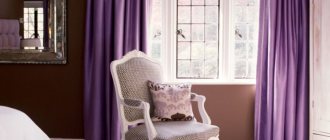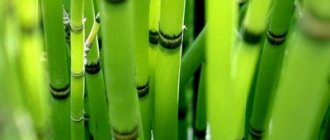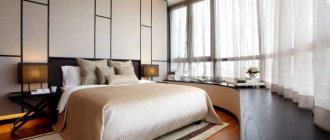What is polycarbonate
There are two types of polycarbonate - cellular and monolithic. For roofing work, as well as for the construction of auxiliary buildings on the site, including gazebos and greenhouses, the cellular version is mainly used. This is a transparent, flexible sheet material consisting of three layers:
- Upper layer . It is a sheet of polycarbonate, which is covered on top with a protective film that does not allow sunlight to destroy the material.
- The middle layer is a cellular layer. Hollow cells with polycarbonate walls give the material high thermal insulation characteristics and also make it lightweight. The walls of the cells act as a kind of stiffening ribs, due to which the material is characterized by quite high strength.
- The bottom layer is another solid sheet of polycarbonate, but without a protective coating.
Transparent polycarbonate for greenhouse Source eddi.ru
Advantages of polycarbonate greenhouses
Not so long ago, only glass and polyethylene were used to build greenhouses. In the first case, the resulting structures were heavy and fragile, which were also quite difficult to install. But the use of polyethylene film usually did not justify itself, since this material wears out quickly and also collects dirt and dust. Therefore, when the opportunity arose to make greenhouses from practical and convenient polycarbonate, many homeowners gladly took advantage of this opportunity.
The advantages of greenhouses made from new improved material are:
- strength , allowing the structure to withstand the weight of a sufficiently thick layer of snow;
- good light transmission , since all layers of the material are completely transparent and nothing prevents the sun's rays from penetrating inside;
- low thermal conductivity , thanks to which the plants in the greenhouse are protected from cold and sudden temperature changes;
- durability , which allows you to use the structure for at least 5 years without restoring or repairing it;
- light weight , allowing the use of less expensive materials for the frame and foundation as in the case of a glass greenhouse.
Polycarbonate greenhouse from the inside Source mega27.ru
See also: Catalog of companies that specialize in turnkey installation services for greenhouses and similar structures.
External covering
Good coverage for the construction of greenhouses with steep roof slopes . The disadvantages include a small snow load, as well as the need for a strong foundation, otherwise the structure will move and the glass will crack.
This coating option is more suitable for a winter greenhouse, provided that a single-chamber double-glazed window is used.
A relatively good option, especially if the film is special with a high ability to transmit ultraviolet radiation. Another advantage is ease of installation and delivery .
The main disadvantages are the fragility and the need to remove the film in the winter.
Polycarbonate
Ideal for covering . Polycarbonate is able to take the required shape and withstand significant loads, subject to certain rules for choosing and caring for a greenhouse.
If you are going to grow a large assortment of plants, then the best option is to buy transparent polycarbonate. But what kind of polycarbonate is used for greenhouses?
You should pay attention to the thickness of the sheet. If it is less than 4 millimeters, then it is not worth purchasing. Although it is possible, provided that the frame is covered with two layers of polycarbonate.
Quite good performance is achieved by sheets 6 millimeters thick, which have an additional inner layer that will prevent condensation from accumulating inside the polycarbonate greenhouse. The best, in the opinion of experts and in terms of do-it-yourself repairs, are polycarbonate greenhouses.
Please note the presence of a coating that protects polycarbonate from destruction under the influence of UV radiation . And also do not forget about the polycarbonate foundation for the greenhouse.
The layer that protects against ultraviolet radiation must face upward during installation. Installation on the contrary will lead to a reduction in the service life of polycarbonate instead of the stated 10 (actually about 15) to 3, maximum 4 years.
Sheets marked “for indoor use” are also not suitable for use. They have no protection from the sun's rays. For protection, the most commonly used method is varnishing.
You should not purchase polycarbonate sheets that are marked “Economy”. This is an indication of the presence of recycled polymer, which reduces the strength of polycarbonate sheets .
The video below will help you choose the right polycarbonate greenhouse.
So, you have decided what the arches of the greenhouse frame will be made of, and you have also decided on the thickness of the polycarbonate slabs for the floor. Consider purchasing specialized fittings. This includes elements that securely hold the polycarbonate in place , excluding ruptures of the polymer and water entering through them.
Read also: Chrysalidocarpus, care features and possible difficulties
With repeated exposure to moisture and sun, the tape will peel off and microorganisms will enter the open channel. As a result, light transmission will decrease, and your greenhouse will shine with a “swamp green” color. Treatment is carried out with steam-permeable sealing tape.
Which polycarbonate to choose
The main characteristics for a greenhouse are good light transmission, reliable heat retention and strength. To obtain a structure with optimal performance, polycarbonate sheets with a thickness of 4 to 10 mm should be used.
The thinner the material, the more expensive and heavier it is. Some conscientious manufacturers use polycarbonate of different thicknesses to create one design. Thus, arched elements are subject to more severe loads during strong winds and precipitation, so they are made of thicker material. Straight and side walls can be constructed from thinner polycarbonate.
Polycarbonate sheets are available in a standard width of 210 cm. Sheets can be 6 or 12 meters long. These parameters are taken into account when drawing up a drawing of the future greenhouse.
Drawing of an arched polycarbonate greenhouse Source stroymoda-nk.ru
It is worth noting that the quality of the finished greenhouse directly depends on the characteristics of the polycarbonate. At the same time, there is a large amount of counterfeit material on the market today that does not have the declared properties. This means that you should purchase finished construction or material for it only from reliable suppliers with extensive experience and an impeccable reputation.
Installation
Foundation for a polycarbonate greenhouse
Installation of an arch-type polycarbonate greenhouse is divided into three stages.
Base structure
We accept a strip-type base made of reinforced concrete. Work in progress:
- marking the area, leveling if necessary. Determination of base points of the foundation;
- digging a trench under the foundation. The depth is calculated taking into account the required height of the foundation (400 mm) and a shock-absorbing “cushion” of crushed stone, gravel or sand (50...100 mm), which is 500 mm. Width – 250…300 mm;
- tamping the “pillow” for pouring. The filling of bulk material is controlled by thickness, tamping is mandatory - this will help avoid “leakage” of liquid concrete and increase the strength of the base;
- installation of formwork. Boards or special plywood are chosen as removable formwork. The height of the formwork depends on the design of the greenhouse - if there are high beds, a rise of 100...150 mm above the ground surface is sufficient;
- fittings are arranged. For further installation of trusses, sections are released above the surface of the future foundation or glasses are installed under the racks with a given pitch. Lightweight structures are mounted on a concrete base in situ;
- Liquid concrete is being poured. To create a foundation, you can take the mixture proportions 1: 3: 5 (cement: sand: crushed stone), adding half the volume of the dry mixture with water;
- after the concrete base has hardened (12...16 days), the foundation is waterproofed with roofing felt and/or additional masonry made of brick or aerated concrete (foam concrete, timber) to increase the height of the greenhouse.
Frame installation
A pipe made from a metal profile can be welded in advance, creating ready-made trusses, or installed on site. The first option is more convenient, especially when using templates - the correct uniform shape of the trusses will facilitate their connection with longitudinal connections and reduce the work time. Truss welding can be done while the foundation is curing.
When assembling the frame by welding, a point connection is used; it is permissible to strengthen the connections with gussets and corners. Places for fastening polycarbonate sheets are drilled in place, taking into account the permissible fastening pitch and ease of installation. Demonstration of how to make a greenhouse with your own hands from polycarbonate based on a metal profile and a prepared base in the video.
Fastening cellular polycarbonate panels
When installing panels, it is important to take into account the property of polycarbonate to expand under the influence of heat. Therefore, the sheets are attached either with an overlap (6...8 cm), or with the installation of special connecting profiles
Fastening cellular polycarbonate panels
The sheets are directly attached to the metal frame elements using self-tapping screws so as not to damage the honeycomb structure of the sheets.
Correct fastening of polycarbonate sheets
If connecting profiles are used, there is no danger of damaging the panels, the seams are sealed and tight, and there is still room for thermal expansion of the material.
An important installation element is the installation of end protection on the panel. This can be self-adhesive tape or an end profile.
Installation via connection profile
Frame
In order for the structure to last as long as possible, you need to choose the right material for the frame that will hold the walls of the greenhouse. The most economical option is a wooden frame. If the wood is treated with a special protective antiseptic before installation, its service life will be at least 10 years.
A frame made of a metal profile will be more reliable, but also more expensive. This is the option used by manufacturing companies. A metal frame will last longer than a wooden one, and it is much more convenient to assemble.
Foundation
It is advisable to install the greenhouse on a foundation, despite the fact that its weight will not exceed 200 kg, and the risk of subsidence on the ground under its own weight is minimal. The fact is that, firstly, in winter, precipitation settling on the walls of the greenhouse will significantly increase its weight. In addition, if it stands without a foundation, then cold air from the street can penetrate through the gap between the soil and the walls. There are known cases when during the summer the air temperature dropped below zero at night. In a greenhouse standing on “bare” soil, all the plants can die in one night.
Another reason to make a simple foundation is that it will provide good protection from the penetration of weeds and harmful insects. And for high-quality fixation of the frame, it is also needed.
Optimal width and length of the greenhouse
The size of the greenhouse must correspond to the area of the site and its purpose. It should be taken into account that it should not be covered with shadow from other objects, and next to it you need to leave space for open beds. Experienced gardeners recommend the following greenhouse sizes:
- wall height – from 160 cm;
- width – from 235 cm;
- length – from 6 meters (corresponding to the length of the polycarbonate sheet).
It should be taken into account that with a wall height of 160 cm, the ridge will be located much higher. The minimum width is calculated for two beds and a passage between them. If you have the desire and opportunity to have a greenhouse with several beds, you can make it wider. So, each additional bed will take another 1 meter + 35 cm per passage.
The length of the greenhouse can be quite large, but it is advisable to plan it as a multiple of 6 meters - along the length of the sheet of material. The best option is to build an elongated shape into two beds with a walkway. The more plants you plan to grow, the longer the greenhouse and the beds in it should be. However, if it is impossible to allocate a long, elongated section of the yard for the structure, you can build a square or even round greenhouse.
Compact square greenhouse Source mojateplica.ru
Which greenhouse is better?
Currently, there are various greenhouses, differing in various parameters: shape, frame, type of material. The main characteristics when choosing a greenhouse are:
- form;
- dimensions;
- frame;
- PVC pipes;
- manufacturing materials;
- wall thickness of polycarbonate.
One of the most important selection parameters is shape. You can find greenhouses of various shapes : pitched, semicircular, arched, rectangular. The most popular and easiest to install are arched structures.
Various types of covering material can be easily attached to them - polycarbonate, film, etc. Soft and lightweight materials , so the installation of such structures does not require the construction of a foundation.
The disadvantage of such structures is the inability to grow plants near the walls. Caring for them also presents some difficulties, since the summer resident has to be in an uncomfortable, bent position. Such structures are more suitable for growing seedlings than for year-round cultivation.
A rectangular greenhouse is optimal . However, its installation requires a foundation, since due to the use of heavy materials in the structure, the soil under it may sag. Similar difficulties arise when purchasing pitched greenhouses.
It must be remembered that without the appropriate skills you will not be able to make such a greenhouse yourself; it is better to turn to specialists . The most suitable for growing vegetables are arched structures. They are quite functional and their installation is relatively simple.
Greenhouse size
Don't forget about the sizes. When choosing such a structure, it is necessary to take into account the size of the area where it is supposed to be installed. If its area is small, preference should be given to a small-sized greenhouse.
It should be taken into account that it must be spacious in width so that, if necessary, it can be increased in length. It will be much more difficult to complete a narrow structure, which will have to be completely rebuilt.
Medium-sized greenhouses can be attached to the wall of a residential building or outbuilding. In this case, free space is saved, as well as materials. Since one of the walls of the structure will already be ready, and there will be no need to create a strong frame.
The disadvantage of this installation method is the high humidity in the greenhouse, which will cause the wall of the building to be constantly damp, which, at a comfortable temperature, can cause the appearance of fungus, which can subsequently penetrate inside the building.
large greenhouses on large areas. Construction trusses are used for their production, and installation of such structures in small dachas is impractical.
It is important to choose a quality frame. It can be made of metal, wood or PVC pipes. Each of these materials has a number of advantages and disadvantages.
PVC pipes are selected separately. They are optimal for building a greenhouse; they can be made in an arched or semicircular shape . Even an inexperienced builder can bend them and drill them.
However, during self-construction, this process is difficult to complete alone, since it is impossible to simultaneously secure the ends, bend the tubes and ensure that there are no distortions. The advantage of this material is its resistance to high humidity , so this greenhouse will last a very long time.
Covering materials for greenhouses
It is also worth choosing high-quality materials for the greenhouse. In particular, the following are in demand: aluminum, wood, galvanized steel, covering material.
Pay attention to aluminum. When installing such a structure, it is necessary to create a foundation. This material is lightweight; when exposed to moisture for a long time, it begins to collapse. The main advantages are simple installation of elements and low cost of material compared to other types.
You can choose galvanized steel . This material is most suitable for greenhouse construction, as it has the necessary strength and durability. Any covering can be attached to such a frame.
Wood is offered as an alternative . This material does not emit harmful substances in the greenhouse, which is very important for vegetables. And its price is quite low, which makes it possible, even with limited finances, to build a medium-sized greenhouse.
But this material also has several disadvantages. During construction, a wooden frame must be treated with a special impregnation to prevent its premature destruction from exposure to moist air. In addition, the wooden frame quickly becomes unusable from exposure to rodents or insects.
It is not recommended to use toxic liquids to protect it, as they will evaporate inside the structure and enter the soil, which will negatively affect plant growth. Be sure to pay attention to the correct choice of covering material . As a rule, various materials are used in this capacity:
The most popular is polycarbonate , which is used to cover medium and large structures. It is lightweight, allows light to penetrate into the structure and has good strength.
The use of film is more suitable for covering small greenhouses. It is used, as a rule, for only one season . Because under the influence of precipitation it begins to sag and eventually becomes unusable. The advantages of this material are low price and lightness.
Glass is now rarely used , since although it transmits light, it retains warm air. In addition, this material is very dangerous if handled carelessly and requires the construction of a foundation.
Greenhouse shape
Polycarbonate greenhouses are manufactured in several standard configurations. They are single-pitch, gable, arched and teardrop-shaped.
Single-pitch
A structure with a pitched roof can be either free-standing or wall-mounted. The wall option is ideal for small areas. The advantages of such a greenhouse:
- good thermal insulation;
- economical consumption of materials;
- ease of installation.
There are also obvious disadvantages:
- the wall of the house does not allow the greenhouse to fully warm up;
- the structure may be damaged by snow or ice falling from the roof of the house.
Polycarbonate lean-to greenhouse Source vi.decorexpro.com
Gable
A design reminiscent of a classic house. Suitable in cases where you need to build a polycarbonate greenhouse whose dimensions are larger than average. Has the following advantages:
- maximum usable area;
- allows you to grow tall plants;
- good light transmission;
- simplicity in the arrangement of the ventilation system.
Minuses:
- increased consumption of materials, which is reflected in the final cost of the structure;
- it is necessary to ensure that sealing is maintained at the junction of the slopes and walls.
Gable greenhouse made of polycarbonate Source sbgreenhouse.com
Arched
The most practical form. There is no joint between the walls and the roof part, and at the same time, the arc-shaped configuration contributes to the rapid and effective removal of sediment.
Advantages:
- an arched building can be of any size, since it is easy to assemble a frame to fit any dimensions;
- high resistance to wind load;
- mobility - it can be easily dismantled and installed in another place;
- low consumption of materials.
Disadvantages:
- not suitable for growing tall crops;
- it is difficult to arrange ventilation.
Arched polycarbonate greenhouse Source stroyportal.ru
teardrop-shaped
Drop-shaped greenhouses have the most aesthetic design. They combine the characteristics of an arched and gable structure.
Advantages:
- increased strength;
- precipitation drains well from the surface of the structure;
- high light transmittance.
Flaws:
- difficulty of assembly;
- high price.
There are also more original forms of such structures. For example, you can build a mini-greenhouse with an opening top in the form of a breadbox or a round domed greenhouse. The choice depends on the requirements for the design. The most practical options are gable and arched shapes.
Drop-shaped greenhouse made of polycarbonate Source ro.decorexpro.com
Optimal greenhouse shape
Which greenhouse shape is best? If you want to build a greenhouse at your dacha, this is one of the first questions that arises. There are arched, semicircular, rectangular, and pitched greenhouses. The name here speaks for itself. There are, in addition to those listed, design options for greenhouses. But they settle on sites quite rarely.
The best greenhouses, based on ease of installation and functionality, are considered to be arched structures.
- Firstly, it is quite easy to manually attach the covering material to them, be it a film or even soft polycarbonate.
- Secondly, the design of such a greenhouse allows you to grow tall plants even right next to the walls, which cannot be said about semicircular greenhouses.
The rectangular shape of the greenhouse is considered suitable for any use. But the difficulty lies in the construction of the greenhouse. In this case, you need to first make a foundation, since due to the use of heavy materials, the ground under the greenhouse may sag. The same can be said about pitched greenhouses. Please note that you will not be able to build greenhouses of such shapes on your own; in any case, you will have to involve an experienced specialist in the work to do everything correctly.
Read also: Aspen: medicinal properties and use in folk medicine
